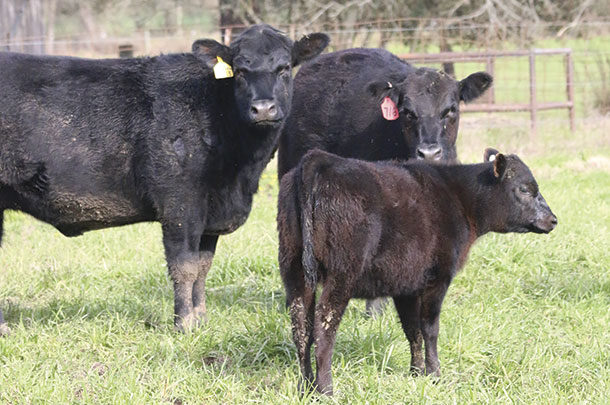Many publications on pregnant cow nutrition note the changing nutrient demands during pregnancy, calving and lactation. Nutrient needs are at their highest during peak lactation and slowly decline as the calf grows and begins to consume more feedstuffs than milk. A cow’s nutrient demands are at their lowest at weaning (assuming weaning occurs when the calf is around 7 months old) and won’t increase again until she is late in the second trimester of pregnancy, moving into the third.
From month to month, these changes in nutrient needs may not seem like much, but between the low and high needs, energy requirements change by more than 50% and the protein requirements by more than 75%. In addition, some mineral requirements can nearly double, depending on the stage of pregnancy or lactation. The size and age of the cow, and changes in the weather, can affect these numbers even more.
Let body and forage conditions be your guide
In the U.S., beef cow body condition can be scored or evaluated using a scale of 1 to 9, with 1 signifying the cow is very thin and 9 indicating the cow is very fat. Most cattlemen will agree that an optimal condition score is between 5 and 6.
Evaluating body condition, or “scoring,” is a practice every producer should get in the habit of doing regularly. There are several key times of year when it makes the most sense to evaluate condition, particularly during calving, breeding, weaning and during mid to late gestation.
There are several smartphone apps which can assist with body scoring. These apps allow the user to keep records, a photo journal and more. Keeping and looking at previous photos is a good way to compare and track the small changes which could go unnoticed by daily observation but which, over time, can add up. When making nutritional and other management decisions for a cow herd, remember, body condition affects everything from bred cow nutrition to performance.
Energy requirements
If cows are thin due to drought, heavy lactation or other reasons which are not health-related, gaining condition during midgestation is relatively easy, provided calves are weaned and an adequate forage resource exists.
Using a protein supplement during this time is generally very effective. Too often supplementation is “put off” until colder weather or after forage conditions have significantly declined; gaining condition later in gestation or during the harsher winter weather conditions is much more costly and inefficient than doing so in midgestation.
Both body condition and the age of the animal can affect its energy requirements, especially in younger cows and heifers. Younger animals are still growing and simply need more feed; for example, a 1,000-pound bred heifer entering her third trimester needs around 1 pound more of total digestible nutrients (TDN) (energy) than a 1,200-pound cow.
So supplementation can be more beneficial to younger animals who are still growing when it is provided earlier and at a higher level. As cows approach calving and enter lactation, their energy needs become more similar, even for cows of different ages.
For thin cows and heifers, the energy requirements are higher to begin with; again, it’s about 1 pound more than cows in adequate body condition. There are several reasons why thin and moderately conditioned cows have increased energy requirements: Thin cows have less fat and are more deeply affected by cold temperatures, and they also lose more muscle mass when they lose weight.
Burning fat and, especially mobilizing muscle tissue to meet energy requirements, are very inefficient metabolic functions. Overall, it is difficult to increase the body condition of a cow which does poorly during the winter without a great deal of additional feed and expense.
Colostrum quality
Colostrum is key to building the immune system of a newborn calf. Beef calves are essentially born without an immune system, and the first immunity they receive is through passive transport via the immunoglobulins in their mothers’ milk. Numerous studies have shown how nutrition impacts colostrum quality, which is measured by its immunoglobulin or antibody concentration.
Be mindful of this when developing supplement strategies for bred cows, since the first few hours of a calf’s life may be the most important of all. How well a calf gets started will influence health and performance throughout its lifetime.
In addition to having mother cow diets satisfied for protein and energy, providing effective trace mineral supplementation from organic sources – along with products which support overall gut health – can support both colostrum quantity and quality.
Impacts on dystocia and fertility
The belief that supplementing cows prior to calving causes more calving difficulties is a myth. While overfeeding and fostering fat cows can increase instances of dystocia, underfeeding or having poorly conditioned cows is a bigger concern. Thin cows are often weaker, have more calving difficulty, and birth more calves with weak calf syndrome or which are less thrifty.
Additionally, thin cows may have poor colostrum quality and a decreased mothering ability because of cow weakness. These issues will almost guarantee that calves born to thin cows will be penalized from birth. Finally – and perhaps most importantly – cows in thin condition at calving will suffer from poor reproductive performance; they often fail to conceive or will have a much longer postpartum interval (i.e., they breed late).
Focusing on the body condition of beef cows is a starting point on the road to improved beef cow nutrition. This and forage quality usually dictate what type of supplement strategy will provide the best results. Body condition and forage quality are important year-round. Calving seasons are perhaps not as traditional as they once were; spring calving may be defined as any time from January to June and fall calving may happen between August and December.
No matter when your calving season occurs, the same principles of body condition and beef cow nutrition apply. The costs associated with health problems and lost opportunities due to poor nutrition programs in pre- and post-calving are significant. There’s never a good time to “cheat” a cow by compromising nutrition. Remember, it pays to take care of the cows which are responsible for paying your bills.








